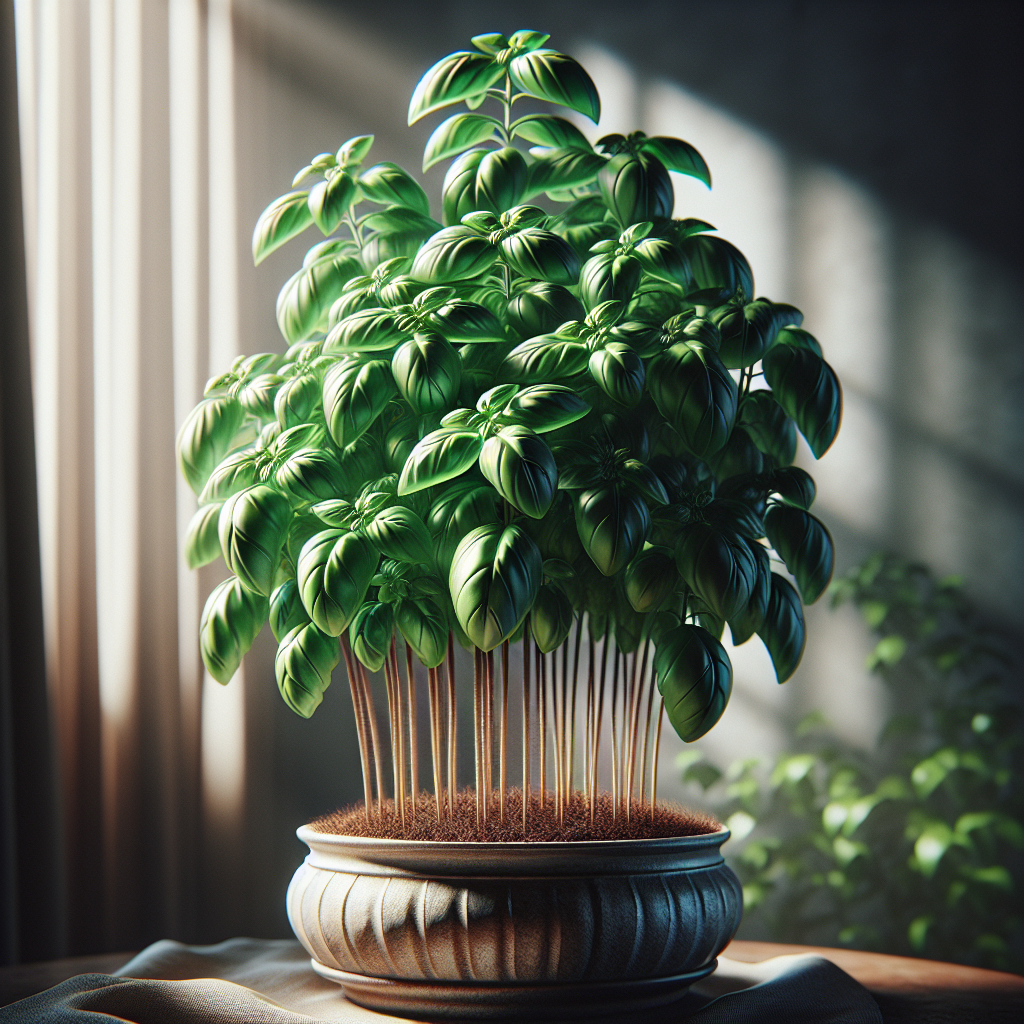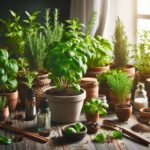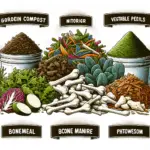Benefits of Growing Basil Indoors
Growing basil indoors not only adds a touch of green to your living space but also provides a host of benefits that go beyond just enhancing the aesthetics. Here are some key advantages:
1. Convenience and Accessibility
Having fresh basil at arm’s reach means you can easily incorporate its aromatic flavor into your dishes without having to make a trip to the store.
2. Year-Round Harvest
Indoor basil cultivation allows you to enjoy a constant supply of this herb regardless of the season, ensuring that you never run out of this versatile ingredient.
3. Enhanced Flavor and Aroma
Basil grown indoors tends to have a more intense flavor and aroma compared to store-bought varieties, adding a delightful punch to your culinary creations.
4. Health Benefits
This herb is packed with essential nutrients and offers various health benefits, including being rich in antioxidants and potentially having anti-inflammatory properties.
5. Cost-Effective
By growing basil indoors, you can save money in the long run, as you won’t need to purchase fresh herbs regularly, reducing your grocery expenses.
6. Aesthetically Pleasing
Aside from its practical benefits, basil also adds a visual appeal to your indoor garden or kitchen, enhancing the overall ambiance of your living space.
Embrace the joys of cultivating basil indoors and savor the numerous advantages it brings to your culinary endeavors and living environment.
Fresh Herbs at Your Fingertips Year-Round
Embracing the joy of growing your own fresh herbs indoors can be a rewarding and practical experience. With a little effort and the right guidance, you can have a bountiful herb garden right at your fingertips throughout the year. Let’s explore how you can cultivate thriving herbs in the comfort of your own home.
Benefits of Growing Herbs Indoors
Growing herbs indoors offers a range of benefits that make it a delightful activity:
- Convenience: Having fresh herbs readily available can elevate your culinary creations without the need to run to the store.
- Year-Round Access: By indoor gardening, you can enjoy fresh herbs regardless of the season or weather outside.
- Cost-Effective: Growing your own herbs can be more affordable than constantly purchasing them from grocery stores.
- Health Benefits: Fresh herbs add not only flavor but also essential nutrients to your diet.
Essentials for Indoor Herb Growing
Before you start your indoor herb garden, there are a few key essentials to keep in mind:
- Location: Choose a spot in your home that receives ample sunlight, such as a south-facing window.
- Containers: Opt for well-draining containers with sufficient depth for the herbs’ root systems.
- Soil: Use a high-quality potting mix to provide the necessary nutrients for healthy herb growth.
- Watering: Maintain proper watering practices to prevent both underwatering and overwatering.
Caring for Your Indoor Herb Garden
To ensure your indoor herb garden flourishes, remember these essential care tips:
- Pruning: Regularly trim your herbs to promote growth and prevent overcrowding.
- Fertilizing: Consider supplementing your herbs with a balanced fertilizer to sustain their vitality.
- Pest Control: Keep an eye out for pests and take prompt action to protect your herbs from infestations.
By following these guidelines, you can cultivate a thriving herb garden indoors and enjoy the fresh flavors of basil, mint, thyme, and more all year long.
Cost-effective Compared to Store-bought Basil
When compared to purchasing basil from a store, growing your own basil indoors can be remarkably cost-effective in the long run. Not only does it offer a sustainable option, but it also provides numerous benefits for your wallet.
Benefits of Growing Basil Indoors
- Initial Investment: While there may be some initial costs to set up your indoor basil garden, the long-term savings outweigh the upfront expenses.
- No Constant Repurchasing: With your own basil plant, you no longer need to buy fresh herbs frequently, saving you money on each grocery trip.
- Continuous Harvest: Indoor basil plants can provide a continuous supply of fresh herbs, reducing the need to purchase more from the store.
Comparative Cost Analysis
Let’s delve into a brief cost analysis to understand the economic advantages of growing basil indoors:
| Cost Factors | Store-bought Basil | Indoor-grown Basil |
|---|---|---|
| Initial Setup | N/A | Low cost for seeds or seedlings, soil, and containers |
| Ongoing Expenses | Regular purchase of basil | Minimal for water and occasional fertilization |
| Frequency of Purchase | Regularly | One-time investment for seeds or seedlings |
Final Thoughts
Growing basil indoors not only saves money but also offers a sense of fulfillment and satisfaction as you nurture your own herb garden.
Choosing the Right Basil Varieties
When it comes to growing basil indoors, selecting the right variety is crucial for a successful harvest. Different types of basil offer varying flavors, scents, and appearances, so choosing the best one for your needs is essential.
Factors to Consider
- Flavor: Consider the taste profile you prefer, whether it’s sweet, spicy, or with hints of citrus.
- Growth Habit: Some basil plants grow compactly, making them ideal for small spaces, while others are more bushy.
- Appearance: Basil varieties come in different leaf colors and sizes, adding aesthetic appeal to your indoor garden.
Popular Basil Varieties for Indoor Growth
Here are a few well-loved basil varieties that thrive when grown indoors:
- Sweet Basil: Known for its classic basil flavor, perfect for various dishes and pesto.
- Genovese Basil: A favorite among chefs for its strong fragrance and large, dark green leaves.
- Thai Basil: Adds a unique anise or licorice flavor to Asian cuisines.
- Lemon Basil: Infuses a delightful citrusy scent and taste to salads and seafood dishes.
Cultivating Multiple Varieties
If you have space, consider cultivating a few different basil varieties to create a diverse herb garden. This allows you to experiment with flavors and scents while adding visual interest to your indoor space.
Sweet Basil for Classic Flavor
When it comes to cultivating sweet basil for that classic flavor in your dishes, there are a few key points to keep in mind. Sweet basil is a versatile herb that can elevate a wide range of dishes with its fresh and aromatic profile.
Choosing the Right Variety
Sweet basil varieties:
- Genovese Basil: Widely recognized for its strong flavor and large leaves, ideal for making pesto.
- Thai Basil: Features a hint of licorice flavor, perfect for Asian cuisine.
Optimal Growing Conditions
Growing sweet basil indoors requires:
- Light: Place your basil plant where it can receive at least 6-8 hours of sunlight daily or use a grow light.
- Temperature: Maintain a warm environment around 70-75°F (21-24°C) for optimal growth.
- Watering: Keep the soil consistently moist but not waterlogged to prevent root rot.
Harvesting and Pruning
Regularly harvest your basil leaves to encourage growth and prevent the plant from flowering. Pinch off the top leaves to promote bushier growth.
Maintaining Flavor
Store fresh basil: Place stems in a glass of water on the countertop or cover with a plastic bag in the refrigerator. Avoid storing basil in the fridge for long periods as it can wilt quickly.
By following these guidelines, you can enjoy the robust and classic flavor of sweet basil in your culinary creations.
Thai Basil for a Hint of Licorice
Thai basil, with its exotic flavor profile, is a fantastic addition to any indoor herb garden. Its distinctive taste reminiscent of licorice adds a unique twist to your culinary creations.
Growing Thai Basil Indoors
- Location: Choose a bright spot receiving at least 6-8 hours of sunlight.
- Soil: Plant in well-draining soil with a pH of 6 to 7.
- Watering: Keep the soil consistently moist but not waterlogged.
- Temperature: Thai basil thrives in temperatures around 65-75°F (18-24°C).
Caring for Thai Basil
- Pruning: Regularly pinch off the top leaves to encourage bushier growth.
- Fertilizing: Use a balanced liquid fertilizer every 2-4 weeks during the growing season.
- Pests: Watch out for aphids and spider mites; treat them with insecticidal soap if necessary.
Harvesting Thai Basil
To preserve the plant’s flavor, harvest the leaves regularly. Use them fresh or dry them for long-term storage.
Using Thai Basil in Cooking
Thai basil is a versatile herb that pairs well with Asian dishes like stir-fries, curries, and noodle soups. Its aromatic leaves can elevate salads, marinades, and even cocktails.
Setting Up Your Indoor Basil Garden
Gathering Supplies
Before starting your indoor basil garden, make sure you have all the necessary supplies ready:
- Pots or containers: Choose pots with drainage holes to prevent overwatering.
- Organic potting soil: Ensure good drainage and aeration for healthy basil plants.
- Basil seeds or seedlings: Select a basil variety that thrives indoors.
- Light source: Place your basil plants in a location with at least 6-8 hours of sunlight daily.
- Watering can: Use a watering can with a narrow spout to water basil plants evenly.
Planting Basil
Now that you have your supplies ready, follow these steps to plant basil indoors:
- Fill the pot: Fill the pot with organic potting soil, leaving some space at the top for watering.
- Plant the seeds: Plant basil seeds 1/4 inch deep in the soil or transplant seedlings carefully.
- Water gently: Water the soil evenly without making it too soggy; basil prefers slightly moist soil.
- Provide sunlight: Place the pots in a sunny spot or use grow lights to ensure adequate light for growth.
Caring for Your Basil Plants
Once your basil is planted, maintain its growth and health by following these care tips:
- Watering: Water basil when the top inch of soil is dry, but avoid waterlogging.
- Pruning: Regularly pinch off the top leaves to encourage bushier growth and prevent flowering.
- Fertilizing: Feed your basil plant with a balanced liquid fertilizer every 4-6 weeks during the growing season.
- Pests and diseases: Keep an eye out for common basil pests like aphids and diseases such as fungal infections.
Harvesting Basil
Enjoy fresh basil from your indoor garden by harvesting it correctly:
- Harvesting leaves: Pick individual leaves or trim stems just above a pair of leaves to promote new growth.
- Regular harvesting: Harvest basil regularly to prevent flowering and encourage more foliage production.
- Storage: Store fresh basil leaves in the refrigerator or freeze them for later use in recipes.
Selecting the Perfect Container
When it comes to growing basil indoors, selecting the right container is crucial for the health and growth of your plants. Let’s delve into some key considerations for choosing the perfect container:
Size Matters
1. Choose a container that is spacious enough to accommodate the root system of the basil plant.
2. An ideal container size for growing basil indoors is around 6 to 8 inches in diameter.
Drainage is Essential
1. Opt for a container with drainage holes to prevent waterlogging, which can lead to root rot.
2. Ensure proper drainage by placing a layer of small stones at the bottom of the container before adding soil.
Mater
1. Consider using terracotta or clay pots as they are porous and allow air circulation to the roots.
2. Alternatively, plastic or resin containers are lightweight and retain moisture better.
Appearance and Aesthetics
1. Choose a container that complements your indoor space and adds to the visual appeal of your home.
2. Get creative with unique containers like decorative pots or repurposed containers for a personalized touch.
By considering these factors, you can select the perfect container for your indoor basil plants, promoting optimal growth and enhancing the ambiance of your living space.
Providing Adequate Sunlight and Temperature
Ensuring your indoor basil thrives involves providing it with the right amount of sunlight and maintaining an optimal temperature. Here are some essential tips to help you create the ideal environment for your basil plant:
1. Sunlight Requirements
Basil thrives in a sunny location where it can receive at least 6-8 hours of sunlight daily. Consider the following:
- Place your basil plant near a south-facing window where it can receive ample sunlight.
- If natural light is limited, consider using grow lights to supplement the sunlight.
2. Ideal Temperature
Maintaining the right temperature is crucial for the health of your basil plant. Here’s what you need to know:
- Keep the temperature around 70-75°F (21-24°C) during the day for optimal growth.
- Avoid exposing your basil to extreme temperatures or drafts, as they can stress the plant.
3. Monitoring Conditions
Regularly check the sunlight exposure and temperature levels in the area where your basil plant is located. Remember:
“Consistent observation of light and temperature conditions is key to ensuring your basil plant’s well-being and productivity.”
By following these guidelines and adjusting as needed, you can provide your indoor basil with the ideal sunlight and temperature conditions for it to flourish.
Planting and Caring for Basil
Basil is a delightful herb to grow indoors, providing fresh flavors to your dishes and a touch of greenery to your home. Proper planting and care are essential to ensure your basil thrives. Here are some key tips to help you cultivate a flourishing basil plant:
Planting Basil
- Choose the Right Pot: Select a pot that is at least 6 inches in diameter and has drainage holes to prevent waterlogging.
- Use Quality Soil: Opt for well-draining soil with a pH level around 6 to 7.
- Sow the Seeds: Plant basil seeds about 1/4 inch deep in the soil and keep them moist until they germinate.
- Provide Adequate Light: Basil thrives in bright, direct sunlight, so place your pot in a sunny spot.
Caring for Basil
- Watering: Water your basil plant when the top inch of soil feels dry, but avoid overwatering as it can lead to root rot.
- Pruning: Regularly pinch off the top leaves to encourage bushier growth and prevent flowering.
- Fertilizing: Feed your basil plant with a balanced liquid fertilizer every 4-6 weeks during the growing season.
- Harvesting: Harvest basil leaves from the top down, using them fresh or drying them for later use.
Remember, basil is a herb that loves warmth, so keep it away from drafts and cold temperatures. With proper care and attention, you can enjoy a bountiful harvest of fresh basil leaves for your culinary creations.
Starting from Seeds or Seedlings
Choosing Between Seeds and Seedlings
When embarking on your basil-growing journey, one of the initial decisions you’ll need to make is whether to start from seeds or seedlings. Each option has its advantages and considerations.
Starting from Seeds: An Adventurous Beginning
- Cost-Effective: Seeds are generally more budget-friendly compared to purchasing seedlings.
- Varied Selection: Starting from seeds offers a wide range of basil varieties to choose from, allowing you to experiment with different flavors and appearances.
- Learning Experience: Witnessing the entire growth process from seed to plant can be a rewarding learning experience.
Starting from Seedlings: A Convenient Option
- Time-Saving: Seedlings provide a head start in the growing process, allowing you to enjoy fresh basil sooner.
- Less Room for Error: Seedlings are more established plants, reducing the risk of unsuccessful germination or early growth challenges.
- Immediate Harvest: With seedlings, you can start harvesting your basil sooner than if you were to begin from seeds.
Considerations for Success
Regardless of whether you choose seeds or seedlings, proper care and attention are essential for successful basil cultivation. Be mindful of factors such as watering, sunlight exposure, temperature, and soil quality to ensure your basil thrives and provides you with a delightful yield.
Watering and Fertilizing Tips
Watering Guidelines
Proper watering is essential for the healthy growth of your indoor basil plants. Here are some guidelines to keep in mind:
- Consistent Moisture: Basil prefers consistently moist soil, so ensure you water whenever the top inch of soil feels dry.
- Do Not Overwater: Avoid soggy conditions as it can lead to root rot; allow excess water to drain freely.
- Watering Frequency: Depending on the environment, water your basil plant every 2-3 days, adjusting as needed.
Fertilizing Tips
Feeding your indoor basil plants with appropriate nutrients can enhance their flavor and growth. Consider the following fertilizing tips:
- Quality Fertilizer: Use a balanced and water-soluble fertilizer to promote healthy foliage and flavorful leaves.
- Frequency: Fertilize your basil plant every 3-4 weeks during the growing season, sparingly in winter.
- Avoid Excess: Over-fertilization can result in nutrient buildup, leading to issues; follow recommended doses.
Pruning and Harvesting Basil
Pruning and harvesting basil are crucial steps in maintaining the health and flavor of your basil plants. Proper techniques ensure a bountiful harvest and encourage robust growth for continuous enjoyment.
Pruning Basil
Pruning basil is essential for promoting bushier and healthier plants. Follow these steps:
- Start Early: Begin pruning when the plant has at least six sets of leaves.
- Pinch the Tops: Regularly pinch off the top set of leaves to encourage lateral growth.
- Remove Flowers: Pinch off any flower buds that develop to divert energy back into leaf production.
Harvesting Basil
Harvesting basil at the right time ensures the best flavor and prolongs the plant’s life. Here are some tips:
- Choose the Right Time: Harvest in the morning when the oils are most concentrated.
- Use Sharp Scissors: Cut the stems above a leaf node to encourage new growth.
- Regular Harvesting: Regularly harvest leaves to stimulate the plant and prevent flowering.

With proper pruning and harvesting techniques, your basil plants will thrive, providing you with an abundant supply of fresh basil for culinary delights.
Promoting Bushier Growth with Regular Pruning
Introduction
Pruning is a critical practice in cultivating bushier basil plants. By trimming and shaping your basil regularly, you can encourage healthier growth and higher yields. In this section, we will delve into the importance of pruning and provide you with practical tips to promote bushier basil plants.
The Importance of Pruning
Pruning plays a crucial role in shaping the growth of basil plants. Here are some key reasons why regular pruning is essential:
- Promotes Bushier Growth: Trimming encourages the basil plant to grow more lateral branches, resulting in a fuller and bushier appearance.
- Improves Air Circulation: Pruning helps enhance airflow around the plant, reducing the risk of diseases caused by moisture buildup.
- Increases Harvest Yield: By removing excess foliage, the plant can focus its energy on developing more flavorful leaves, boosting your harvest.
Pruning Techniques
When it comes to pruning basil, the following techniques can help you achieve bushier growth:
- Pinching: Regularly pinch off the top set of leaves when the plant reaches about six inches in height. This will encourage branching and a more compact growth habit.
- Harvesting: Harvesting the outer leaves regularly not only provides you with fresh basil but also stimulates new growth from the center of the plant.
- Cutting Back: Trim back any leggy or overgrown stems to promote denser foliage and prevent the plant from becoming too top-heavy.
Timing of Pruning
It is crucial to prune your basil plants at the right time to maximize the benefits. Aim to prune in the morning when the plant is well-hydrated and less stressed. Avoid pruning during the hottest part of the day to prevent wilting.
Quote
“Pruning is not just about cutting away, but about enabling new growth and vitality in your basil plants.”
Conclusion
Regular pruning is a simple yet effective way to promote bushier growth in your indoor basil plants. By incorporating proper pruning techniques into your routine, you can enjoy a healthier and more abundant harvest of fresh basil.
Harvesting Techniques for the Best Flavor
Timing Is Key
Harvest your basil leaves in the morning after the dew has dried but before the sun gets too hot. This is when the flavor is at its peak.
Handpicking Method
1. Pick Individual Leaves: Gently pluck the largest, outermost leaves first, starting from the top of the plant. Avoid damaging the stems and surrounding foliage.
2. Pinch or Cut: Use clean, sharp scissors or pinch the stems just above a leaf pair or node to encourage bushier growth.
Regular Pruning
Trimming your basil plant regularly encourages new growth and ensures a continuous supply of fresh leaves. Aim to prune every 2-3 weeks, especially before the plant flowers.
Avoid Flowering
“Pinch flower buds as soon as you see them. Once basil flowers, the leaves can turn bitter and the plant focuses its energy on seed production.”
Storing Method
1. Rinse and Dry: Wash the harvested leaves gently, pat them dry with paper towels, and allow them to air dry completely.
2. Use or Preserve: Utilize the basil immediately for the freshest taste, or preserve it by freezing, drying, or infusing in oil.
Dealing with Common Basil Growing Issues
When growing basil indoors, you might encounter a few common issues that can hinder the plant’s growth and health. Here are some tips to help you address and overcome these problems:
Pest Infestations
- Inspect your basil plant regularly for any signs of pests such as aphids, spider mites, or whiteflies.
- Treat the infestation promptly using organic solutions like neem oil or insecticidal soap.
- Consider introducing beneficial insects like ladybugs to help control pest populations naturally.
Fungal Diseases
- Avoid overwatering your basil, as excessive moisture can lead to fungal diseases like powdery mildew.
- Ensure proper air circulation around the plant by placing it in a well-ventilated area.
- If fungal diseases persist, remove and destroy the affected leaves to prevent further spread.
Yellowing Leaves
- Monitor your basil’s watering habits to prevent both under and overwatering, which can cause yellowing leaves.
- Ensure your basil plant is receiving adequate sunlight as insufficient light can also result in yellow leaves.
- Consider adjusting the temperature and humidity levels in the growing environment to promote healthy leaf color.
Wilting and Drooping
- Check the soil moisture regularly and water your basil plant when the top inch of soil feels dry to the touch.
- Provide consistent watering to avoid fluctuations that can stress the plant and lead to wilting.
- If wilting persists, consider repotting your basil in fresh, well-draining soil to improve root health.
Stunted Growth
- Ensure your basil plant is receiving sufficient nutrients by fertilizing it with a balanced, water-soluble fertilizer according to the recommended dosage.
- Prune your basil regularly to encourage new growth and prevent overcrowding that can stunt the plant’s development.
- Monitor the temperature and humidity levels to create an optimal environment for basil growth.
Pests and Diseases Management
Preventative Measures
Preventing pests and diseases is essential to ensure the health of your indoor basil plants:
- Proper sanitation: Regularly clean your gardening tools and containers to prevent the spread of diseases.
- Adequate air circulation: Ensure good airflow around the plants to discourage the development of fungal infections.
- Optimal watering: Avoid overwatering, as excessive moisture can attract pests and lead to root rot.
- Quality soil: Use well-draining soil to prevent waterlogging, which can create a favorable environment for diseases.
Common Pests
Keep an eye out for these common basil pests:
- Aphids: These small insects can be controlled with a strong spray of water or insecticidal soap.
- Spider mites: Increase humidity and regularly mist your plants to deter these tiny pests.
- Whiteflies: Introduce natural predators like ladybugs or use yellow sticky traps to catch these flying insects.
Identifying Diseases
Recognizing signs of basil diseases early can help in effective management:Downy Mildew – Look for yellowing leaves with fuzzy gray growth on the undersides. Powdery Mildew – Symptoms include white powdery spots on the leaves and stems. Fusarium Wilt – Watch for wilting, yellowing, and stunted growth, often caused by soil-borne fungi.
Control and Treatment
When facing pests or diseases, consider these control methods:
- Organic Sprays: Utilize neem oil or insecticidal soap for gentle yet effective pest management.
- Fungal Treatments: Apply a copper-based fungicide for fungal infections like mildew.
- Isolation: Separate infected plants to prevent the spread of diseases to healthy ones.
Preventing Nutrient Deficiencies
Understanding Nutrient Deficiencies
Before addressing how to prevent nutrient deficiencies in your indoor basil plants, it’s essential to grasp the signs and symptoms. Nutrient deficiencies manifest in various ways, such as yellowing of leaves, stunted growth, or leaf drop.
Choosing the Right Potting Mix
Selecting a high-quality potting mix rich in organic matter is crucial for providing essential nutrients to your basil plants. Look for mixes specifically designed for herbs to ensure optimal growth.
Proper Watering Techniques
Overwatering or underwatering can lead to nutrient deficiencies in basil plants. Establish a consistent watering schedule based on the plant’s needs and the moisture level of the soil. Use a moisture meter to determine the appropriate watering frequency.
Fertilizing Wisely
While nutrient-rich soil is vital, fertilizing plays a significant role in preventing deficiencies. Choose a balanced, liquid fertilizer specifically formulated for herbs and apply it according to the manufacturer’s instructions.
Monitoring Plant Health
- Regularly inspect your basil plants for any signs of nutrient deficiencies.
- Address issues promptly to prevent further damage.
- Keep a gardening journal to track your plant’s progress and any changes in growth.
Seeking Professional Advice
Consulting with a horticulturist or experienced gardener can provide valuable insights into preventing and addressing nutrient deficiencies in your indoor basil plants. Don’t hesitate to seek expert guidance when needed.
Creative Ways to Use Fresh Basil
When it comes to utilizing fresh basil in your culinary creations, the possibilities are truly endless. Here are some creative ways to make the most out of this fragrant herb:
1. Basil Pesto
One of the most popular uses for fresh basil is to make a delicious basil pesto sauce. Simply blend fresh basil leaves with pine nuts, garlic, Parmesan cheese, and olive oil for a versatile sauce that can be used on pasta, sandwiches, or as a dip.
2. Infused Olive Oil
Enhance the flavor of your dishes by infusing olive oil with fresh basil. Simply heat the olive oil gently with basil leaves to impart a subtle basil flavor to your cooking.
3. Caprese Salad
For a refreshing and simple dish, layer fresh basil leaves with sliced tomatoes and mozzarella cheese. Drizzle with balsamic glaze and olive oil for a classic Caprese salad.
4. Basil Butter
Combine softened butter with chopped fresh basil for a flavorful spread that is perfect for bread, seafood, or grilled vegetables.
5. Basil Lemonade
Infuse your homemade lemonade with fresh basil leaves for a unique and refreshing twist on a classic drink. Add some sliced lemons and a sprig of basil for a beautiful presentation.
6. Herb-Infused Salt
Create a gourmet herb-infused salt by mixing fresh basil leaves with coarse sea salt. Use this aromatic salt to season your dishes for an added depth of flavor.
Experiment with these creative ways to use fresh basil and elevate your culinary creations to new heights!
Delicious Basil Recipes to Try
Basil is a versatile herb that can elevate the flavor of many dishes. Whether you’re a seasoned cook or just starting in the kitchen, these delicious basil recipes are sure to impress.
1. Classic Caprese Salad
- Ingredients: Fresh basil leaves, ripe tomatoes, fresh mozzarella, extra virgin olive oil, balsamic glaze, salt, and pepper.
- Instructions: Layer the basil leaves, tomatoes, and mozzarella on a serving platter. Drizzle with olive oil and balsamic glaze. Season with salt and pepper.
2. Pesto Pasta
- Ingredients: Fresh basil leaves, pine nuts, garlic, Parmesan cheese, extra virgin olive oil, salt, and pepper.
- Instructions: Blend the basil, pine nuts, garlic, and Parmesan in a food processor. Slowly add olive oil until smooth. Toss with cooked pasta and season to taste.
3. Basil Lemonade
- Ingredients: Fresh basil leaves, lemons, sugar, water.
- Instructions: Make a simple syrup with sugar and water. Blend basil leaves with lemon juice and mix with the syrup. Serve over ice for a refreshing drink.
4. Tomato Basil Bruschetta
- Ingredients: Ripe tomatoes, fresh basil, garlic, extra virgin olive oil, balsamic vinegar, baguette slices.
- Instructions: Combine diced tomatoes, chopped basil, minced garlic, olive oil, and balsamic vinegar. Spoon onto toasted baguette slices for a tasty appetizer.
Making Homemade Basil-Infused Oils and Vinegars
Infusing Oils with Basil
To make homemade basil-infused oils, follow these simple steps:
- Wash and dry fresh basil leaves thoroughly.
- Place the basil leaves in a clean, dry glass jar.
- Heat olive oil until warm (not boiling) and pour it over the basil leaves.
- Let the mixture cool and steep for a few days in a cool, dark place.
- Strain out the basil leaves and transfer the infused oil to a clean bottle for storage.
Creating Basil-Infused Vinegars
For homemade basil-infused vinegars, try the following method:
- Wash and dry fresh basil leaves completely.
- Place the basil leaves in a sterilized glass jar.
- Warm white vinegar (or any vinegar of your choice) and pour it over the basil leaves.
- Secure the jar with a non-metallic lid and let it sit in a cool, dark spot for about a week.
- Strain out the basil leaves and transfer the flavored vinegar to a clean container.
Tips for Success
- Quality Ingredients: Always use fresh, high-quality basil for the best flavor.
- Cleanliness is Key: Ensure all equipment and jars are clean and dry before starting.
- Patience Pays Off: Let the infusions sit for an adequate time to fully develop the flavors.
Quote to Inspire
“Infusing oils and vinegars with basil adds a touch of freshness and depth to your culinary creations.”
Frequently Asked Questions (FAQs)
General Questions
Q: How often should I water my indoor basil plant?
A: It’s essential to keep the soil slightly moist but not waterlogged. Aim to water your basil plant when the top inch of soil feels dry to the touch.
Lighting Requirements
Q: What kind of light does basil need indoors?
A: Basil thrives in bright, indirect sunlight. Ensure your indoor basil plant receives at least 6-8 hours of sunlight daily for optimal growth.
Pruning and Harvesting
Q: How should I prune my basil plant?
A: Regularly pinch off the top leaves to encourage bushier growth. Avoid pruning more than one-third of the plant at a time.
Pest Control
Q: How can I prevent pests from infesting my indoor basil?
A: Regularly inspect your plant for pests like aphids or spider mites. Consider using natural remedies such as neem oil or insecticidal soap to keep pests at bay.
How often should I water my indoor basil plant?
Proper watering is crucial for the health and growth of your indoor basil plant. Here are some essential guidelines to help you determine the right watering frequency:
1. Assess the Soil Moisture
Before watering your basil plant, check the soil moisture levels. Stick your finger about an inch into the soil – if it feels dry to the touch, it’s time to water.
2. Establish a Routine
Consistency is key when it comes to watering basil. Develop a watering schedule based on the plant’s needs and the moisture level of the soil.
3. Consider Environmental Factors
Factors like temperature, humidity, and the amount of sunlight your basil plant receives can influence its water requirements. Adjust your watering frequency accordingly.
4. Avoid Overwatering
While basil plants need regular watering, overwatering can lead to root rot and other issues. Ensure proper drainage to prevent waterlogged soil.
5. Wilting Leaves
If you notice the leaves wilting, it might be a sign of underwatering. Adjust your watering schedule to ensure the plant receives adequate moisture.
By paying attention to your indoor basil plant’s needs and adapting your watering routine accordingly, you can help it thrive and flourish.
Can I Grow Basil Indoors Without Natural Sunlight?
When considering growing basil indoors, the availability of natural sunlight plays a crucial role in the success of your plants. However, if you’re facing challenges with natural light, there are alternative methods to help your basil thrive indoors.
Supplemental Lighting
To grow basil indoors without natural sunlight, consider using supplemental lighting such as LED grow lights. These lights mimic natural sunlight and can provide the necessary light spectrum for plant growth.
Duration and Intensity
Ensure that the duration and intensity of the supplemental lighting match the needs of basil plants. Typically, basil plants require around 6-8 hours of sunlight equivalent lighting each day for optimal growth.
Positioning
Place the supplemental lighting above the basil plants, maintaining an appropriate distance to prevent burning the leaves. Consider adjusting the positioning as the plants grow to ensure they receive adequate light coverage.
Monitoring and Care
Regularly monitor the growth and health of your basil plants. Adjust the lighting, watering, and care routines as needed to support healthy growth in the absence of natural sunlight.
Considerations
While it is possible to grow basil indoors without natural sunlight, it is essential to understand the plant’s requirements and provide suitable alternatives. With proper care and attention to lighting, your indoor basil garden can flourish even without the sun’s direct rays.







